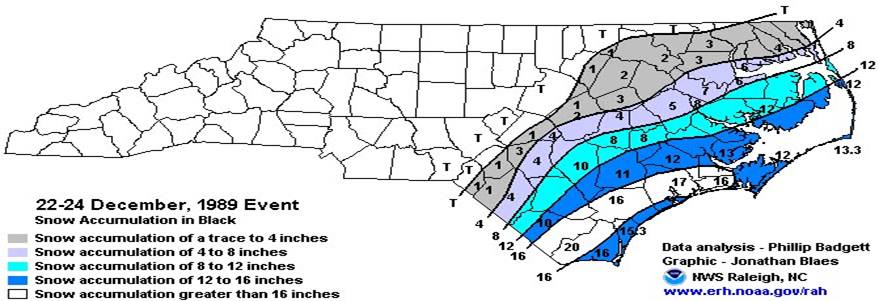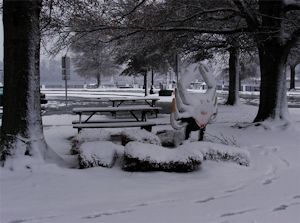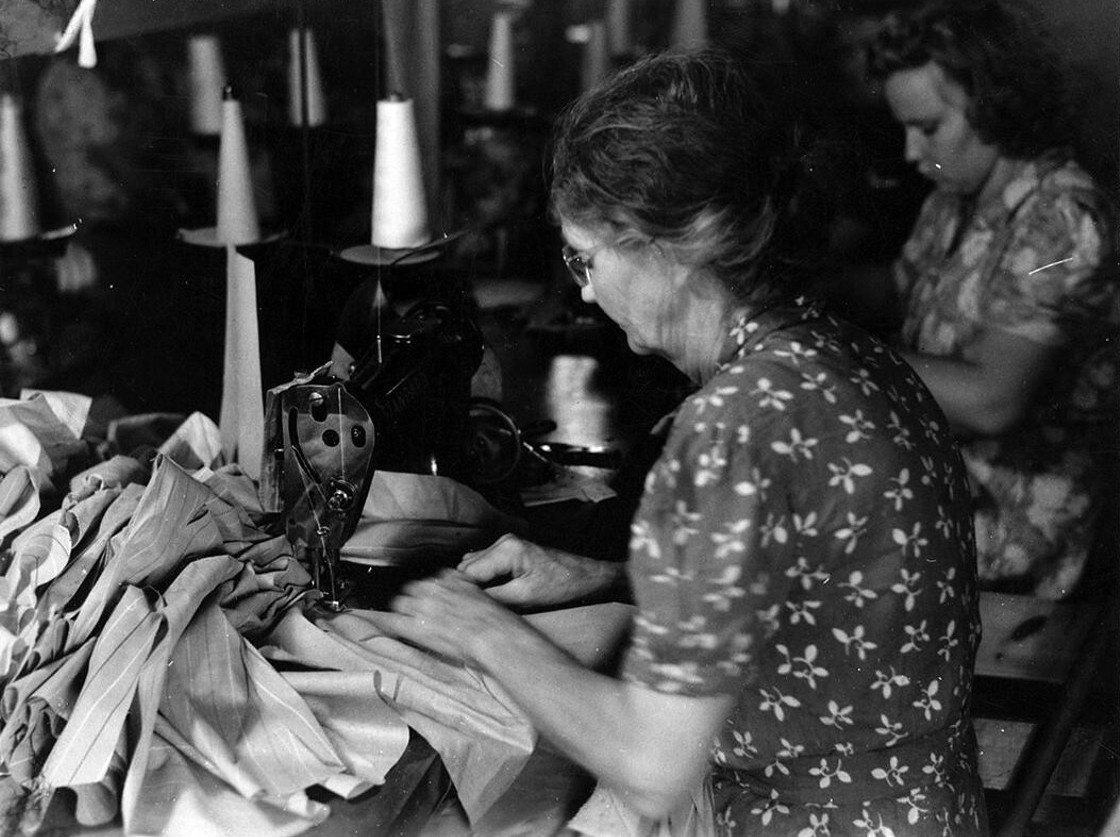 Wilmington looked more like Anchorage on Christmas Eve, 1989. |
WILMINGTON — December has almost been more like summer than winter in southeastern North Carolina the past two years.
It wasn’t so different in 1989 – until a few days before Christmas.
Supporter Spotlight
“It looked like just a typical December,” said Tim Armstrong, a meteorologist with the National Weather Service Forecast Office in Wilmington. “Earlier in the month it was in the 60s and 70s.”
The snow started falling just before midnight on Friday, Dec. 22, 1989. First there was an inch. Then came 9.6 inches on Saturday. And another 4.7 inches on Sunday, Christmas Eve. By Christmas morning, a total of 15.3 inches of snow had fallen and 13 inches continued to blanket the ground in Wilmington as the temperature dipped to 0 degrees.
By Weather Service standards, it was the only white Christmas the Port City and surrounding areas have ever had. The traces of snow that fell in 1948 and 1999 don’t count because they didn’t total an inch.
Both the 1989 snowfall and thermometer reading were historic for the N.C. coast. Snowfall totals were in the double digits throughout the region. Onslow and Carteret counties measured as many as 17 inches. Along the northern coast, snow amounts ranged from 13.3 inches at Cape Hatteras, 10 inches at Manteo to one inch at the Virginia border. Gale-force winds piled snow drifts four to eight feet high all along the coast. Many towns were paralyzed.
“There’s nothing else even close in the entire records that go back to 1871,” Armstrong said. “It takes a lot of crazy finagling in the atmosphere to get snow down here, especially that early in the season.”
Supporter Spotlight
The reason for this is the ocean temperature typically remains above 50 degrees in December, and that tends to throw warm air back onto shore, he said. We’re much more likely to get snow in January and February, when the water temperature bottoms out, he added.
“Generally when we have really cold air we have dry air, so we don’t have any precipitation,” said Rick Krietner, a meteorologist at the Weather Service’s Wilmington office. “If it’s moist enough it’s usually too warm.”
But in 1989, a low-pressure system developed over “a crazy intense Arctic cold mass that came down from Canada,” drawing moisture from the Atlantic back into the cold air, Armstrong said.
The result was a rare coastal North Carolina snow event.
“That was like the perfect storm for the Southeast,” said Mike Caropolo, the meteorologist in charge of the Weather Service office. “Everything has to line up just perfectly. It’s hard to get all those ingredients to come together at the same time here.”

Caropolo was an intern at the Wilmington office in 1989. He said “the forecast had no mention of snow in it.” So he started his drive home to New York for holiday vacation just after he got off work the night of Friday, Dec. 22. The white Christmas didn’t follow him there.
“For the two weeks I was up in New York I didn’t even see a flurry,” Caropolo said.
So could it happen here 23 years later? Not likely, meteorologists say.
The Weather Service website has a page dedicated to Christmas climatology. It shows a white Christmas probability of less than 5 percent for almost all of North Carolina. While it’s a little too soon to make an accurate call for Dec. 25, NWS meteorologists say look for slightly below-normal temperatures but don’t get your hopes up for snow.
Because the ocean temperature at Wrightsville Beach is currently 58 degrees, “it would take a heck of a cold air mass to overcome that heat coming out of the water,” Armstrong said.
But even if not at Christmas, don’t completely count out the possibility of another significant snowfall somewhere down the line in the Port City’s future.
“You just wonder if it’s a matter of time before we get another big winter storm,” Caropolo said.
This year is not likely to break records on the other end of the spectrum, either. The warmest it has ever been on Christmas Day was 77 degrees in 1955.
Those who lived through the coastal winter storm of 1989 remember it well, even more than two decades later.
Kathy Tolley, now single-copy manager at the Star-News, Wilmington’s daily newspaper, had just begun delivering papers for the company a few months before the snowstorm.
“I had a VW Rabbit diesel and it wouldn’t start to get to work,” she said. “They sent one of the district managers after me, and we delivered a route on the way back to the office. It was a nightmare. The city DMs (district managers) were trying their best to deliver to the customers in New Hanover County. They were in vans, sliding all over the place. I think we wound up with one stuck in a snow bank and one in a ditch.”
 About five inches of snow covered downtown Washington in Beaufort County. Photo: Stan Deatherage, Beaufort County Now. |
Gail Smyth of Wilmington did not yet live here back then but was visiting family near Wrightsville Beach.
“The only cars allowed on the road were 4-wheel-drive,” she said. “Thank god my dad had just bought a small Blazer, and being from New England I knew how to drive in the snow. Plus they were using farm equipment to try to clear the roads.”
Kristin Lubben of Boiling Spring Lakes in Brunswick County was also experienced in winter weather.
“We had just a few years earlier moved here from New York and were amazed at all the panic,” she said.
Over in Carolina Beach, some recalled snow drifts that reached several feet high and being stranded on the island for days.
For Carolina Beach resident Ryan Powell, who was 10 at the time, the thrill of a new Christmas present was too much to resist, even in the treacherous weather conditions.
“I got a go-cart that year and almost died when it slid and almost put me in the canal,” he said.
For others, Christmas went on much longer than planned.
“I will never forget my first Christmas in Wilmington,” said former resident Linda Honour, who now lives in Winston-Salem. “Friends visited for the holiday and stayed and stayed and stayed.”
For me, growing up in Sampson County an hour inland we had our fair share of snow that Christmas, too. I remember a photo of my 15-year-old self on the porch wearing my new brown leather bomber jacket, afraid to venture out too far into the snow for fear it would ruin my cherished present. The power was out for some time, and the plunging temperatures caused the whole family to sleep in the living room huddled around the fireplace.







